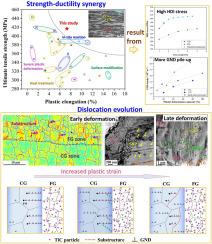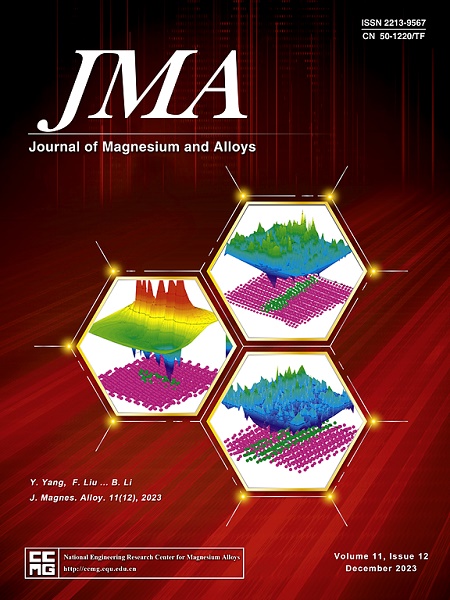揭示双异质结构镁基复合材料中的异质变形诱导(HDI)硬化和位错活性
IF 13.8
1区 材料科学
Q1 METALLURGY & METALLURGICAL ENGINEERING
引用次数: 0
摘要
整合异质结构可显著提高复合材料的强度-电导率协同效应。然而,镁基复合材料中异质结构引起的异质变形诱导(HDI)应变硬化与位错活动之间的关系仍不清楚。在本研究中,与均匀 FG 复合材料相比,双异质 TiC/AZ61 复合材料的塑性延伸率(PEL)显著提高了近一倍,同时保持了较高的强度(UTS:417 兆帕)。这是因为与 FG 和 CG 复合材料相比,异质结构中更严重的变形不均匀性导致更多的几何必要位错(GNDs)积累和更强的 HDI 应力,从而产生更高的 HDI 硬化。在塑性变形的早期阶段,FG 区和 CG 区的 GND 堆积类型明显不同。GND 往往在 FG 区而不是 CG 区形成亚结构。它们只在 CG 区的晶界处堆积,从而导致 CG 区的背应力明显增加。在变形后期,HDI应力的升高激活了CG区新的〈c + a〉位错,导致位错缠结,甚至形成亚结构,进一步推动了异质复合材料的高硬化。然而,对于CG复合材料,〈c + a〉位错即使在大塑性应变下也不会被激活,只有〈a〉位错堆积在晶界和孪晶边界。我们的研究深入了解了异质镁基复合材料中的位错变化和高密度互连硬化。本文章由计算机程序翻译,如有差异,请以英文原文为准。


Revealing Hetero-Deformation Induced (HDI) Hardening and Dislocation Activity in a Dual-Heterostructure Magnesium Matrix Composite
Integrating a heterogeneous structure can significantly enhance the strength-ductility synergy of composites. However, the relationship between hetero-deformation induced (HDI) strain hardening and dislocation activity caused by heterogeneous structures in the magnesium matrix composite remains unclear. In this study, a dual-heterogeneous TiC/AZ61 composite exhibits significantly improved plastic elongation (PEL) by nearly one time compared to uniform FG composite, meanwhile maintaining a high strength (UTS: 417 MPa). This is because more severe deformation inhomogeneity in heterogeneous structure leads to more geometrically necessary dislocations (GNDs) accumulation and stronger HDI stress, resulting in higher HDI hardening compared to FG and CG composites. During the early stage of plastic deformation, the pile-up types of GND in the FG zone and CG zone are significantly different. GNDs tend to form substructures in the FG zone instead of the CG zone. They only accumulate at grain boundaries of the CG region, thereby leading to obviously increased back stress in the CG region. In the late deformation stage, the elevated HDI stress activates the new 〈c + a〉 dislocations in the CG region, resulting in dislocation entanglements and even the formation of substructures, further driving the high hardening in the heterogeneous composite. However, For CG composite, 〈c + a〉 dislocations are not activated even under large plastic strains, and only 〈a〉 dislocations pile up at grain boundaries and twin boundaries. Our work provides an in-depth understanding of dislocation variation and HDI hardening in heterogeneous magnesium-based composites.
求助全文
通过发布文献求助,成功后即可免费获取论文全文。
去求助
来源期刊

Journal of Magnesium and Alloys
Engineering-Mechanics of Materials
CiteScore
20.20
自引率
14.80%
发文量
52
审稿时长
59 days
期刊介绍:
The Journal of Magnesium and Alloys serves as a global platform for both theoretical and experimental studies in magnesium science and engineering. It welcomes submissions investigating various scientific and engineering factors impacting the metallurgy, processing, microstructure, properties, and applications of magnesium and alloys. The journal covers all aspects of magnesium and alloy research, including raw materials, alloy casting, extrusion and deformation, corrosion and surface treatment, joining and machining, simulation and modeling, microstructure evolution and mechanical properties, new alloy development, magnesium-based composites, bio-materials and energy materials, applications, and recycling.
 求助内容:
求助内容: 应助结果提醒方式:
应助结果提醒方式:


